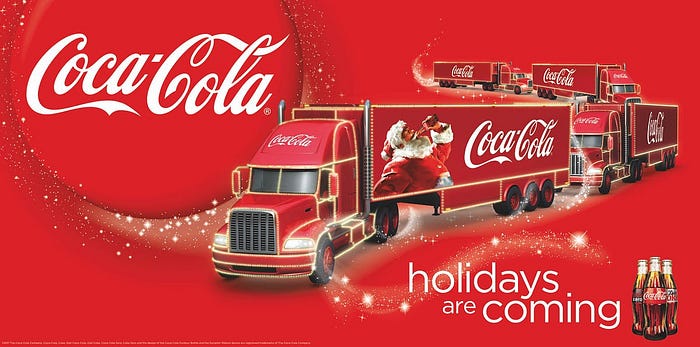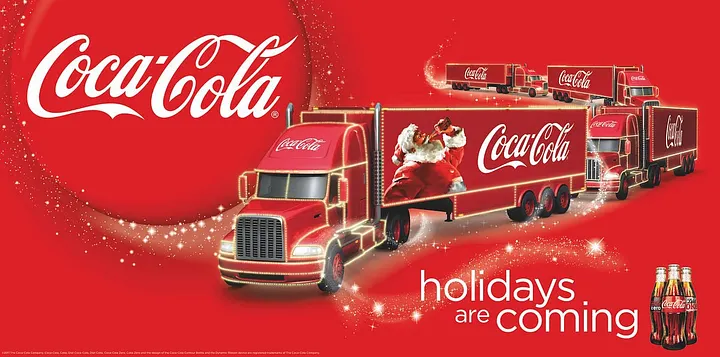How Brands Use Christmas to Boost Their Marketing Campaigns
Christmas is a time of joy, celebration, and generosity. It is also a time of fierce competition among brands, that want to capture the attention and loyalty of consumers. Brands use various marketing strategies to leverage the festive season and create memorable campaigns that resonate with their target audience. In this article, we will explore some of the best Christmas marketing campaigns of 2023 and the strategies behind them.

Some Examples of Successful Christmas Marketing Campaigns that have been released over the past years:
- Coca-Cola — Holidays are Coming: This is one of the most iconic and enduring Christmas campaigns of all time, which started in 1995 and has been running every year since then. The campaign features a fleet of red trucks, decorated with lights and the Coca-Cola logo, driving through snowy landscapes and towns, bringing joy and excitement to the people. The campaign is accompanied by a catchy jingle, which sings “Holidays are coming, holidays are coming”. The campaign aims to associate Coca-Cola with the festive spirit and happiness of Christmas, and to create anticipation and nostalgia among the consumers.
- John Lewis — The Long Wait: This is one of the most popular and emotional Christmas campaigns ever, which was launched in 2011 by the British department store chain. The campaign tells the story of a young boy, who impatiently counts down the days until Christmas, seemingly eager to open his presents. However, on Christmas morning, he rushes past his own gifts and runs to his parents’ bedroom, where he gives them a present he had carefully wrapped himself. The campaign reveals that he was not waiting for his own gifts, but for the joy of giving. The campaign is set to a cover version of The Smiths’ song “Please, Please, Please, Let Me Get What I Want”, sung by Slow Moving Millie. The campaign aims to convey the message that “It’s better to give than to receive”, and to inspire the consumers to find the perfect gift for their loved ones at John Lewis.
- Sainsbury’s — 1914: This is one of the most memorable and controversial Christmas campaigns ever, which was released in 2014 by the British supermarket chain. The campaign recreates the historical event of the Christmas truce of 1914, when British and German soldiers on the Western Front ceased fire and exchanged greetings and gifts on Christmas Day. The campaign focuses on a young British soldier, who shares a moment of friendship with a German soldier, and gives him a chocolate bar as a gift. The campaign ends with the tagline “Christmas is for sharing”, and informs the viewers that the chocolate bar featured in the film is available in Sainsbury’s stores, with all profits going to the Royal British Legion, a charity that supports veterans and their families. The campaign aims to honor the soldiers who fought in the First World War, and to encourage the consumers to share and donate during the festive season.
- IKEA — The Other Letter: This is one of the most touching and thought-provoking Christmas campaigns ever, which was launched in 2014 by the Swedish furniture giant. The campaign shows a group of children, who are asked to write two letters: one to the Three Kings (the Spanish equivalent of Santa Claus), asking for the gifts they want for Christmas, and another one to their parents, asking for what they want from them. The children write their letters, and then are asked to choose which one they would send if they could only send one. The children choose the letter to their parents, which reveals that they want to spend more time with them, play with them, hug them, and have fun with them. The campaign then shows the parents’ reactions, who are moved and surprised by their children’s wishes. The campaign aims to challenge the materialistic culture of Christmas, and to remind the parents and the children of the importance of family and quality time.
- WestJet — Christmas Miracle: This is one of the most surprising and delightful Christmas campaigns ever, which was launched in 2013 by the Canadian airline. The campaign shows a group of passengers, who are waiting to board their flights at Toronto and Hamilton airports, where they encounter a virtual Santa Claus, who asks them what they want for Christmas. The passengers tell Santa their wishes, ranging from socks and underwear, to toys and electronics, to a big-screen TV and a flight home. The campaign then reveals that WestJet employees were listening to the passengers’ wishes, and quickly bought and wrapped the gifts they asked for. The passengers arrive at their destination in Calgary, where they are greeted by a festive baggage carousel, where their personalized gifts appear. The passengers are amazed and overjoyed by the unexpected gifts, and thank WestJet for the Christmas miracle. The campaign aims to spread the magic and generosity of Christmas, and to showcase WestJet’s customer service and care.
The Marketing Strategy Behind These Campaigns
While each of these campaigns had a unique approach and style, they also shared some common elements that made them successful. Here are some of the key marketing strategies behind these campaigns:
- Creating a strong and consistent brand identity: Each campaign reinforced the brand’s identity and values, and differentiated it from the competitors. For example, Coca-Cola’s campaign emphasized its iconic and universal appeal, John Lewis’s campaign showcased its quality and service, and IKEA’s campaign highlighted its innovation and simplicity.
- Tapping into the emotions and needs of the consumers: Each campaign appealed to the emotions and needs of the consumers, such as happiness, love, gratitude, curiosity, or belonging. For example, Sainsbury’s campaign evoked the emotions of pride and compassion, WestJet’s campaign satisfied the needs of surprise and delight, and Pringles’ campaign catered to the needs of fun and interaction.
- Using storytelling and creativity to capture the attention and interest of the consumers: Each campaign told a compelling and engaging story that captured the attention and interest of the consumers, and made them want to watch and share it. For example, John Lewis’s campaign used a twist and a reveal to create suspense and emotion, IKEA’s campaign used a social experiment to create curiosity and reflection, and WestJet’s campaign used a hidden camera to create realism and authenticity.
- Integrating different channels and platforms to reach and connect with the consumers: Each campaign used different channels and platforms, such as TV, online, social media, or in-store, to reach and connect with the consumers, and to create a seamless and immersive experience. For example, Coca-Cola’s campaign used TV, online, and in-store channels to create anticipation and excitement, Pringles’ campaign used online and in-store channels to create interaction and participation, and WestJet’s campaign used online and in-store channels to create surprise and delight.
- Encouraging the consumers to take action and become part of the campaign: Each campaign encouraged the consumers to take action and become part of the campaign, such as buying, sharing, donating, or creating. For example, Sainsbury’s campaign encouraged the consumers to buy the chocolate bar and donate to the charity, LEGO’s campaign encouraged the consumers to share their creations on social media, and Calvin Klein’s campaign encouraged the consumers to visit the website and the stores.
The Result of These Campaigns
These campaigns not only generated a lot of buzz and attention, but also delivered tangible results for the brands. They helped the brands to:
- Increase brand awareness and recognition: The campaigns reached millions of people across different channels and platforms, and made the brands stand out from the crowd.
- Increase brand loyalty and advocacy: The campaigns created a connection and a relationship with the consumers, and made them feel valued and appreciated by the brands.
- Increase traffic and sales: The campaigns drove more visitors and customers to the brand’s website and stores, and increased their revenue and market share.
Conclusion
Christmas is a great opportunity for brands to showcase their products and services, and to connect with their consumers. By using effective marketing strategies, such as aligning the campaign with the brand’s identity and values, creating a catchy and memorable hashtag, leveraging social media and influencers, offering incentives and rewards, and telling a story and evoking emotions, brands can create successful Christmas marketing campaigns that boost their brand image and performance.







